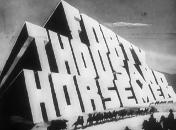AustLit
Latest Issues
AbstractHistoryArchive Description
The narrative begins in Western Australia in 1915 and follows the paths of Archie Hamilton and Frank Dunne, before and after their enlistment in the Australian Imperial Forces. Hamilton is the patriotic son of a grazier and Frank Dunne is a drifter with no great desire to fight for the British Empire. They meet as runners in an outback footrace and become best mates. After training in Egypt, they land at Gallipoli, just as the great Allied assaults of August 1915 are to begin.
Source: Australian Screen.
Notes
-
The trailer for this film is available to view via YouTube: http://www.youtube.com/watch?v=i8e7ECdG69U (Sighted: 10/8/2012)
Publication Details of Only Known VersionEarliest 2 Known Versions of
Works about this Work
-
The Larrikin Girl : Challenging Archetypes in Australian Cinema
2022
single work
criticism
— Appears in: Senses of Cinema , October no. 103 2022;'Australian cinema has travelled a varied trajectory since its initial development in the late 19th century. The cinema reflected the developing social and cultural tropes of its time, as the concept of a distinct Australian identity began to form. But it is clear that a colonial history of Australian film focuses very clearly and emphatically along lines of class and gender. Rose Lucas notes that there is a “cluster of dominant, recognisable images in our cinema” which consists of the bushman, the ocker, the ‘mate’, and the ‘battler’, a series of male coded tropes which are stubbornly pervasive within this national cinema. These archetypes have trained a concentrated gaze upon masculinity in Australian cinema, but there has been little space in this cultural landscape for the development of archetypical women in Australia’s cultural history with very few valued traits that are specifically coded female. This resolutely masculine perspective seems to have shaped the nation and the national cinema, and Lucas’s observation highlights the key archetypes as embodied as masculine. But these archetypes, long the sole domain of masculine representation, also have historically encompassed female experiences. In this paper we identify the need to broaden such a framework, and by taking the most Australian and most masculine of forms – the larrikin – we argue that the larrikin girl has been hiding in plain sight across Australian film history.' (Introduction)
-
Break of Day, Gallipoli and ANZAC Ideology in the Cinema of Disability
2022
single work
essay
— Appears in: Overland [Online] , October 2022; -
Where Are the Australian Anti-War Films?
2021
single work
criticism
— Appears in: Kill Your Darlings [Online] , July 2021; -
Peter Weir’s Gallipoli 40 Years On : Deftly Directed and Still Devastating
2021
single work
column
— Appears in: The Conversation , 19 April 2021;'With the release of the first-world-war film Gallipoli in 1981, director Peter Weir could finally shrug off the nickname he had laboured under since making his first films: “Peter Weird”.'
-
Screening Anzac : Anzac-themed Television in Australia and New Zealand during the First World War Centenary
2020
single work
criticism
— Appears in: Journal of Australian Studies , vol. 44 no. 4 2020; (p. 440-456)'Historians have long sought to compare Australian and New Zealand Anzac commemoration, finding that Australian commemoration tends to be more nationalistic and celebratory, while New Zealand’s is more solemn and inclusive of Māori, women’s and pacifist perspectives. This article examines war commemoration in Australia and New Zealand during the centenary of the First World War through the medium of four Anzac-themed television productions: Australia’s Gallipoli and The Power of Ten and New Zealand’s When We Go to War and Field Punishment No. 1. Due to their capacity to attract mass audiences, television and film are useful mediums for elucidating major cultural trends, including the changing nature of war commemoration and its relationship to ideals of nationhood. In particular, the article argues that the coexistence of myth-challenging representations in Australia with productions that reinforce the traditional Anzac legend reflects a longstanding tension between supporters of the state-sanctioned nationalist trope and its critics in artistic and academic communities; alternatively, the less controversial nature of the Anzac legend in New Zealand helps account for the more prosaic tone of some of its Anzac-themed television.' (Publication abstract)
-
y
 No Picnic : An Autobiography
Sydney
:
Pan Macmillan Australia
,
1995
Z1224962
1995
single work
autobiography
No Picnic : An Autobiography
Sydney
:
Pan Macmillan Australia
,
1995
Z1224962
1995
single work
autobiography
-
Alert and Alarmed: Art Under Fire : Robert Connolly : Filmmaker
2005
single work
column
— Appears in: The Sydney Morning Herald , 29 November 2005; (p. 18) -
The Ethics of Fellowship in Two Antipodean War Films: Gallipoli (1981) and The Lord of the Rings (2001, 2002, 2003)
2005
single work
criticism
— Appears in: Australian Humanities Review , January-February no. 34 2005; Ian Henderson makes connections between Peter Weir and David Williamson's Gallipoli and Peter Jackson's The Lord of the Rings trilogy. -
Fear in Peter Weir's Australian Films : A Matter of Control
2009
single work
criticism
— Appears in: Antipodes , June vol. 23 no. 1 2009; (p. 75-80) Many have noted the prevalence of the emotion of fear in Peter Weir's Australian films. In dealing with this fear, commentators have directed their focus at the world external to that which Weir's characters inhabit. The commentators have asked what is it 'out there' that these characters are so afraid of. As is wont of all good scholars they have attempted to discern an answer that unites Weir's oeuvre. -
Battlers Take Top Spot in Movie Poll
2010
single work
column
— Appears in: The Courier-Mail , 7 October 2010; (p. 13)
Awards
- 1981 winner Australian Film Institute Awards — Best Screenplay, Original or Adapted
-
Gallipoli,
cTurkey,cMiddle East, Asia,





